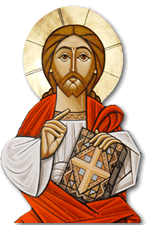Throughout the Fast of Nineveh, the Church fasts for three days, a period in which we reflect on our sins and live in a state of repentance. This fast was first inaugurated during the time of Bishop Zaraa El-Souriany. When fasted by the Church, the fast symbolizes the Ninevites and their thirst for God’s mercy. The readings are all read from the Lectionary of the Great Lent. The Fast of Nineveh is ritualistically similar to the Fast of the Great Lent. It is vital to remember that the Vespers Prayers are not prayed during this fast because they symbolize the sacrifices that are to be offered in the evening, which is Christ Himself sacrificed on the wood of the Cross. Rather, the Divine Liturgies during the Fast of Nineveh end at dusk, reminding us of the real sacrifice offered on the altar. Importantly, Christ Himself relieves the church from the need of offering the evening sacrifices of the Vespers Prayers. The hymns of this fast are chanted in the Great Lenten tune.
Rite
In the Prime Prayer, the Prayer of Thanksgiving is prayed, followed by kereyalson instead of the Verses of Cymbals. In addition, the Litanies for the Sick and those who are Traveling are chanted. The Doxologies are then chanted in the Lenten tune, starting with the Doxology specific to the Fast of Nineveh. After praying Efnoti Nainan, the congregation replies with Keralayson thrice in the minor tune, after which the candles on the altar are put out and the sanctuary veil is closed. Meanwhile, the prophesies of the Great Lent are read in Coptic or the language of understanding. This reminds us of the time when the light of the prophets was extinguished from the time of Malachi the Prophet until the coming of Christ the Lord, Who is the True Light of the world. Upon the completion of the prophecies, the veil of the sanctuary is once again opened and the candles on the altar are relit. The Litanies are then prayed simultaneously with prostrations (metanoia). After the reading of the Gospel, the Gospel Response specific to the Fast of Nineveh is chanted according to the day. Afterwards, the entire Creed is recited.
In the Divine Liturgy, the Seven Canonical Hours are prayed (in the monasteries, the Prayer of the Veil is added). The Rite from this point onwards is similar to that of the Great Lent. Following the offering of the Lamb, the hymn `Alleluia e i ekhon is chanted. After the Thanksgiving Prayer Nefcenti and `eklinomena taghanota along with its responses are said. Then the Absolution is recited and it is followed by the hymn, entho te ti shori . Then, the Hiten specific to the Fast of Nineveh is chanted before that of the Apostles. Following the Catholic Epistle, the hymn share evnoti is chanted. It should be noted that the Gospel Responses should be chanted according to the day of the Fast. After the Prayer of Reconciliation, the Adam Espasmos is said in the same manner it would be in the Lenten days. The priest prays the Fraction of the Lent during the breaking of the Body. During communion, Psalm 150 is chanted in the same tune as that of the Great Lent, without any response, followed by the hymns Jeefesmarot (in the Lenten tune) and Pimairomi . Finally, the concluding hymn, Somatos is chanted, excluding the passage specific to the Lent.
In the Feast of Nineveh, the prayers are chanted in the annual tune. Specific verses for the feast are said in the Prime and Divine Liturgy Gospel Responses, as well as the Hiten . The priest prays the Annual Fraction, and Psalm 150 and the Concluding Canon are chanted in the annual tune.
May the blessings of these blessed days, be with us all. Amen.
Source
Mikhail, Deacon Albair Gamal, The Essentials in the Deacon’s Service, (Shobra, Egypt: Shikolani, 2002), p.336, 337. Translated from Arabic by Ragy Sharkawy, edited by Alexander A-Malek.
